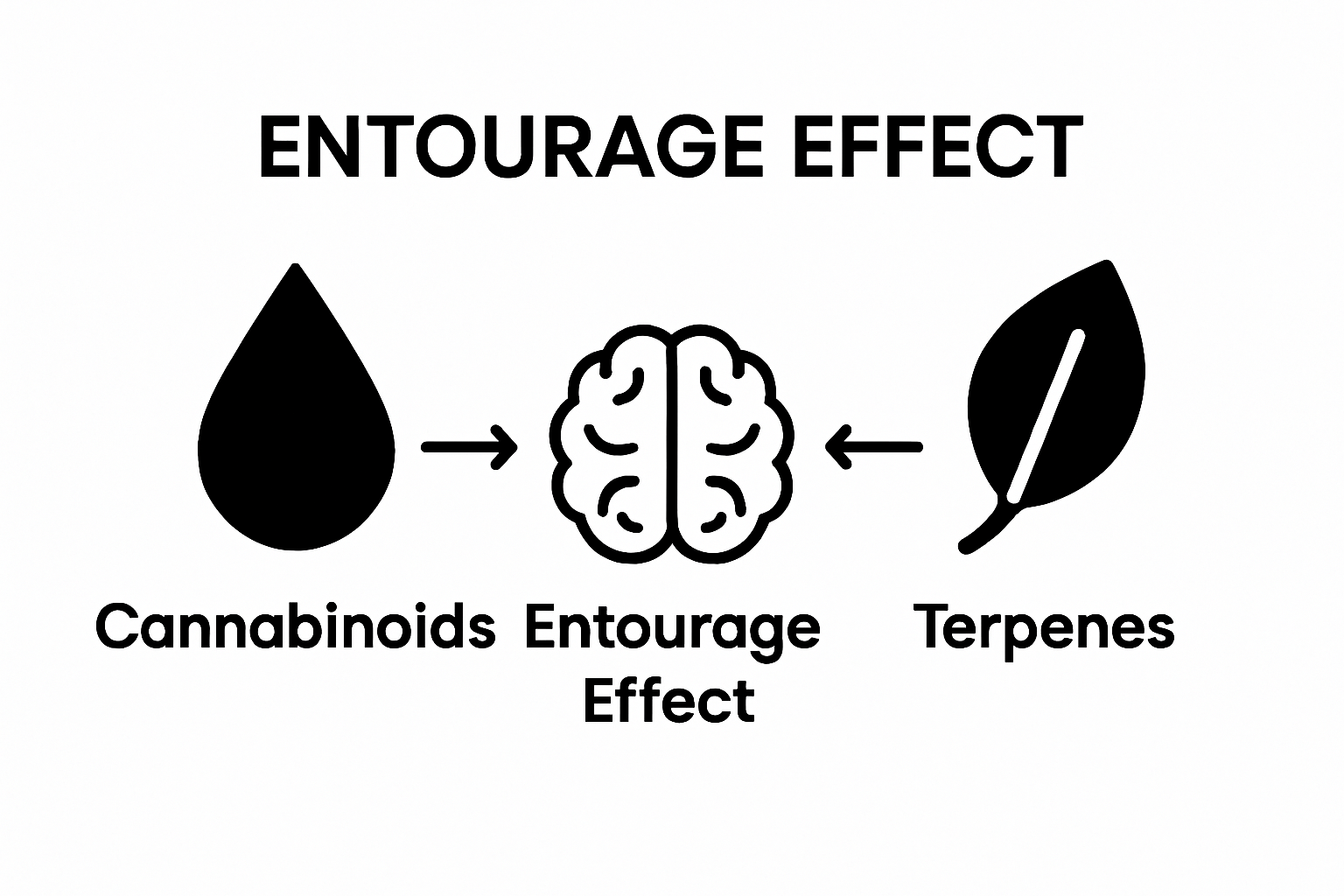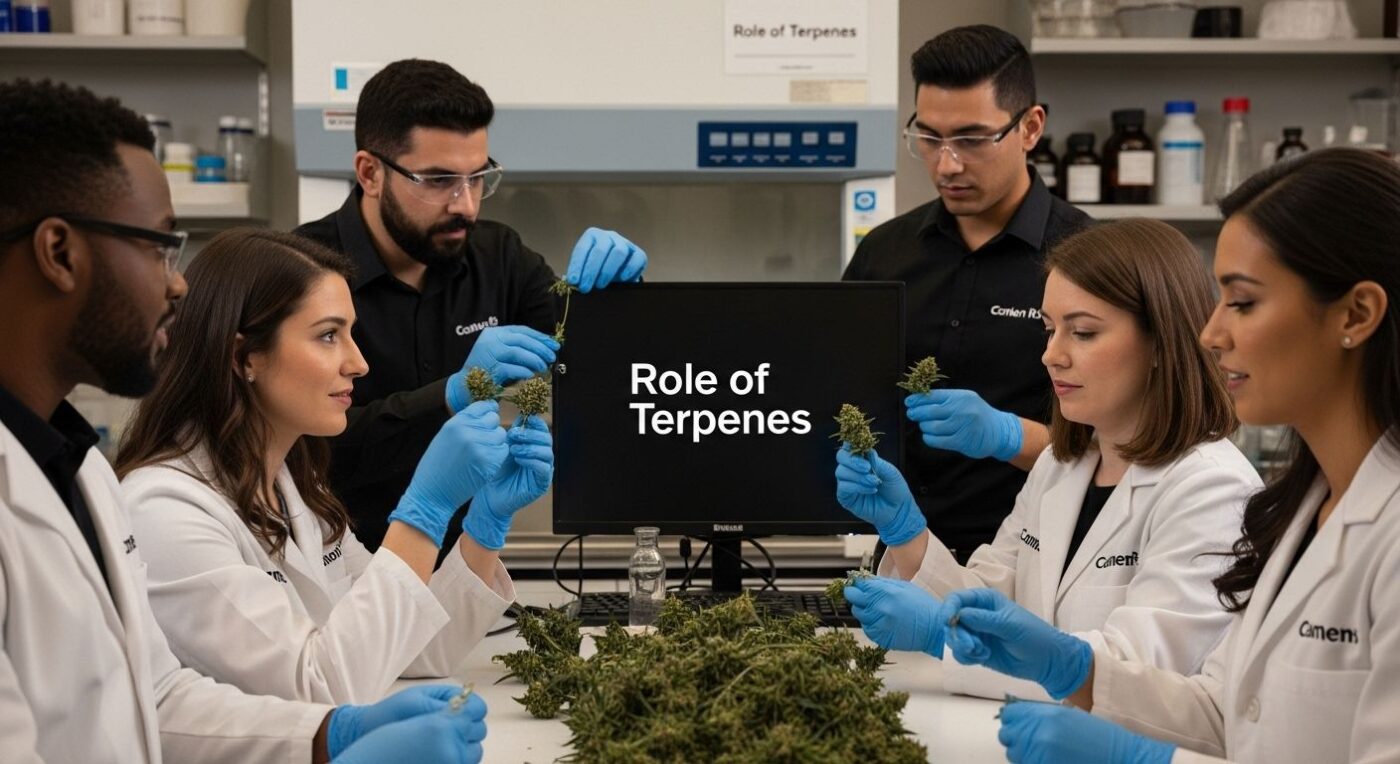Blog
Understanding the Role of Terpenes in Cannabis
Terpenes give cannabis its memorable scents and flavors, and their influence reaches far deeper than smell alone. Most people overlook the fact that cannabis contains over 200 different terpenes, each with its own unique role. Think the real power is in THC or CBD? Picture this: the subtle combination of terpenes might do even more to shape your experience than cannabinoids ever could.
Table of Contents
- What Are Terpenes And Their Characteristics?
- Why Terpenes Matter In Cannabis Products
- How Terpenes Interact With Cannabinoids
- Exploring The Benefits Of Different Terpenes
- The Future Of Terpenes In Cannabis Innovation
Quick Summary
| Takeaway | Explanation |
|---|---|
| Terpenes enhance cannabis experiences. | Terpenes significantly affect sensory experiences, influencing flavors and aromas in cannabis products. |
| Each terpene has unique effects. | Different terpenes affect mood and relaxation; for example, myrcene promotes relaxation while limonene may elevate mood. |
| The entourage effect is crucial. | Terpenes and cannabinoids work together, potentially amplifying therapeutic effects and defining user experiences significantly. |
| Understanding terpenes aids product selection. | Knowledge of terpene profiles helps consumers choose cannabis products that align with desired effects and wellness goals. |
| Future research focuses on terpenes. | Advances in science aim to harness terpenes for targeted therapeutic applications and personalized cannabis products, expanding their potential uses. |
What are Terpenes and Their Characteristics?
Terpenes are fascinating organic compounds that play a critical role in the cannabis plant’s chemical composition and sensory experience. These aromatic molecules are responsible for the distinctive fragrances and flavors found in cannabis and numerous other plants. Unlike cannabinoids which primarily interact with the body’s endocannabinoid system, terpenes offer a unique set of characteristics that contribute significantly to the overall cannabis experience.
The Chemical Nature of Terpenes
At their core, terpenes are hydrocarbons composed of repeating isoprene units. These molecular structures create an incredibly diverse range of compounds, with over 200 different terpenes identified in cannabis alone. Each terpene possesses a unique molecular structure that determines its specific aroma, potential therapeutic properties, and interaction with other plant compounds.
According to research from the National Center for Biotechnology Information, terpenes are not exclusive to cannabis but are widespread in the plant kingdom. They serve multiple evolutionary purposes for plants, including:
- Attracting pollinators
- Deterring potential predators
- Protecting plants from environmental stressors
Terpenes and the Entourage Effect
One of the most intriguing aspects of terpenes is their ability to interact synergistically with cannabinoids, a phenomenon known as the “entourage effect.” This interaction suggests that terpenes do more than just provide aroma they can potentially modulate and enhance the effects of other cannabis compounds. For instance, some terpenes might influence how THC and CBD interact with the body’s receptors, potentially altering the overall experience.
If you want to explore more about the fascinating world of cannabis compounds, read our guide on flavor-specific strains, which delves deeper into how terpenes contribute to unique cannabis experiences.
Why Terpenes Matter in Cannabis Products
Terpenes are far more than just aromatic compounds that give cannabis its distinctive smell. They play a crucial role in defining the overall quality, experience, and potential therapeutic value of cannabis products. Understanding their significance helps consumers and enthusiasts make more informed choices about their cannabis consumption.
Impact on Product Experience
The presence and combination of specific terpenes dramatically influence how a cannabis product will affect an individual. Each terpene brings unique characteristics that can modify the sensory and physiological response. For example, myrcene might promote relaxation, while limonene could potentially elevate mood. These nuanced interactions mean that two cannabis strains with identical cannabinoid profiles can produce entirely different experiences based on their terpene composition.

According to research published in the National Center for Biotechnology Information, terpenes contribute significantly to the therapeutic potential of cannabis through complex molecular interactions. This underscores why discerning consumers look beyond just THC or CBD percentages when selecting products.
Therapeutic and Physiological Significance
Terpenes offer potential health and wellness benefits that extend beyond recreational use. Their therapeutic properties include:
- Anti inflammatory responses
- Potential anxiety reduction
- Pain management support
- Possible neuroprotective effects
The intricate ways terpenes interact with the human body demonstrate their importance in cannabis product development. Some terpenes might enhance absorption of cannabinoids, while others could modulate how these compounds interact with receptors in the endocannabinoid system.
Below is a feature comparison table outlining the unique characteristics, aromas, and potential effects of some key terpenes found in cannabis.
| Terpene | Distinct Aroma | Notable Potential Effect | Example Use or Application |
|---|---|---|---|
| Myrcene | Earthy, musky, herbal | May promote relaxation | Often linked with calming strains |
| Limonene | Citrus, lemon | May elevate mood | Common in uplifting strains |
| Pinene | Pine, fresh | May support alertness/respiratory | Can counteract some THC side effects |
| Linalool | Floral, lavender | May help reduce stress/anxiety | Frequently used for relaxation |
| Beta-Caryophyllene | Spicy, peppery | May offer anti-inflammatory | Targets pain and inflammation |
| Humulene | Woody, earthy | May suppress appetite | Sometimes used for weight management |
If you are interested in diving deeper into how specific terpene profiles influence cannabis experiences, read our comprehensive guide on terpene types, which explores the unique characteristics of different terpene variations.
How Terpenes Interact with Cannabinoids
The relationship between terpenes and cannabinoids represents a complex and fascinating biochemical interaction that goes far beyond simple coexistence. This intricate molecular dance profoundly influences the overall cannabis experience, revealing how these compounds work together to produce unique physiological and therapeutic effects.
The Entourage Effect Mechanism
At the heart of terpene and cannabinoid interaction lies the “entourage effect,” a scientific concept describing how different cannabis compounds amplify and modify each other’s properties. Terpenes do not merely provide aromatic characteristics they actively participate in modulating how cannabinoids interact with the human body’s receptors. Some terpenes can potentially enhance cannabinoid absorption, alter receptor binding, and even influence neurotransmitter production.
According to research published in the National Institutes of Health, these interactions suggest that the combined effect of terpenes and cannabinoids is more significant than their individual contributions. This synergistic relationship means that the same cannabinoid concentration can produce dramatically different effects depending on the terpene profile.

Specific Interaction Mechanisms
Terpenes interact with cannabinoids through several key mechanisms that demonstrate their biochemical complexity:
- Modifying cell membrane permeability
- Influencing neurotransmitter receptor binding
- Enhancing or reducing cannabinoid absorption
- Potentially altering the blood brain barrier transmission
Some terpenes, such as myrcene, can increase cell membrane permeability, potentially allowing faster and more efficient cannabinoid absorption. Others like pinene might counteract short term memory disruption typically associated with THC consumption. These nuanced interactions highlight why a comprehensive terpene profile is crucial for understanding cannabis effects.
This comparison table illustrates how core mechanisms allow terpenes to interact with cannabinoids, affecting overall cannabis experiences and potential therapeutic impact.
| Interaction Mechanism | Description | Example Terpene Effect |
|---|---|---|
| Cell Membrane Permeability | Terpenes can alter membrane permeability, impacting cannabinoid absorption rates | Myrcene may increase THC/CBD absorption |
| Receptor Binding Modulation | Terpenes can influence how cannabinoids bind to neurotransmitter receptors | Pinene may affect memory by modulating THC binding |
| Neurotransmitter Influence | Terpenes may affect neurotransmitter release or activity | Linalool may alter serotonin and GABA signaling |
| Blood-Brain Barrier Transmission | Some terpenes may change how cannabinoids cross the blood-brain barrier | No specific terpene solely responsible, mechanism varies |
If you are curious about exploring the intricate world of cannabis compounds, check out our comprehensive guide on flavor-specific strains, which delves deeper into how different terpene combinations create unique cannabis experiences.
Exploring the Benefits of Different Terpenes
Terpenes represent more than just aromatic compounds in cannabis they are complex molecules with potential therapeutic applications that extend far beyond sensory experiences. Understanding the unique properties of individual terpenes provides insight into how cannabis can potentially support wellness and address various physiological challenges.
Therapeutic Potential of Key Terpenes
Each terpene carries distinctive characteristics that contribute to its potential health benefits. Some notable examples include myrcene, known for potential relaxation effects, and limonene, which might support mood elevation. These compounds interact with the human body in nuanced ways, offering more than simple fragrance profiles.
According to research published in the National Library of Medicine, different terpenes demonstrate remarkable therapeutic properties. Some scientifically documented potential benefits include:
- Anti inflammatory responses
- Potential anxiety reduction mechanisms
- Pain management support
- Possible neuroprotective capabilities
Targeted Health Applications
Terpenes exhibit specialized interactions that make them fascinating from a wellness perspective. For instance, pinene might enhance respiratory function, while linalool could potentially support stress reduction. These compounds work through complex molecular pathways, interacting with neurotransmitter systems and cellular receptors in ways that modern research continues to unravel.
Some terpenes show promise in addressing specific health concerns. Beta caryophyllene demonstrates potential anti inflammatory properties, while humulene might support appetite suppression. These targeted applications highlight the sophisticated nature of cannabis terpenes beyond simple aromatic compounds.
If you are interested in diving deeper into the world of cannabis compounds, explore our comprehensive guide on terpene types, which provides detailed insights into the unique characteristics of different terpene variations.
The Future of Terpenes in Cannabis Innovation
The cannabis industry stands on the cusp of a revolutionary transformation, with terpenes emerging as a critical frontier of scientific exploration and product development. Far from being mere aromatic compounds, terpenes are now recognized as sophisticated molecules with immense potential for personalized cannabis experiences and targeted therapeutic applications.
Scientific Advancement and Research
Modern cannabis research is increasingly focused on understanding the intricate roles of terpenes beyond their traditional perception. Advances in genomics and metabolomics are enabling scientists to map and manipulate terpene profiles with unprecedented precision. This scientific approach allows for more nuanced breeding techniques and product formulations that can potentially address specific health conditions or desired physiological responses.
According to research published in the journal Plants, emerging technologies are transforming how we understand and utilize terpenes. Researchers are now able to:
- Identify specific genetic markers responsible for terpene production
- Develop targeted breeding strategies
- Create more consistent and predictable cannabis cultivars
- Design personalized cannabis products
Emerging Applications and Potential
The future of terpene innovation extends across multiple domains, from medical research to recreational product development. Biotechnology companies are exploring ways to engineer cannabis strains with precise terpene profiles that could potentially address specific health challenges. For instance, researchers are investigating terpene combinations that might offer enhanced pain management, anxiety reduction, or neuroprotective capabilities.
Interestingly, the potential applications are not limited to traditional cannabis consumption. Terpene extracts could find applications in pharmaceuticals, wellness products, and even industries like aromatherapy and natural medicine. The versatility of these compounds suggests we are only beginning to understand their comprehensive potential.
If you are curious about the evolving landscape of cannabis compounds, explore our comprehensive guide on flavor-specific strains, which provides deeper insights into the fascinating world of cannabis innovation.
Elevate Your Cannabis Experience With Terpene-Rich Products
If you are curious about how terpenes shape your cannabis journey, we understand the challenge of finding truly authentic products that deliver the full benefits and flavors described in our article. Many consumers struggle to identify trustworthy sources for premium vapes, pre-rolls, and edibles with accurate terpene profiles. At Puff Laco, we address these concerns with a focus on verified authenticity and rigorous quality testing, giving you the confidence to experience the real impact of terpenes. Taste the difference with flavor-specific strains and full spectrum extracts expertly crafted for both recreational and medicinal needs.
.png)
Ready to discover which terpene-rich product matches your goals? Visit our main site at Puff Laco to explore our exclusive vapes, gummies, and disposables. Let our detailed product guides and verified reviews help you choose with confidence. Shop now to unlock special offers and start benefiting from superior terpene-enhanced cannabis today.
Frequently Asked Questions
What are terpenes in cannabis?
Terpenes are aromatic organic compounds found in cannabis and many other plants. They are responsible for the distinctive fragrances and flavors in cannabis and can influence the overall experience and effects of the strain.
How do terpenes affect the cannabis experience?
Terpenes interact with cannabinoids in a phenomenon known as the “entourage effect,” which means they can modify and enhance the effects of cannabinoids like THC and CBD, leading to different experiences even with similar cannabinoid profiles.
Can terpenes provide health benefits?
Yes, terpenes may offer potential therapeutic benefits, including anti-inflammatory properties, anxiety reduction, pain management support, and possible neuroprotective effects. Their interactions with the body can contribute to wellness beyond recreational use.
How do different terpenes interact with cannabinoids?
Different terpenes can modify how cannabinoids interact with the body’s receptors. Some terpenes enhance cannabinoid absorption or alter receptor binding, which results in varying effects and therapeutic responses based on the specific terpene profile of a cannabis strain.
Recommended
- 7 Terpene Types Explained
- Understanding What Are Flavor-Specific Strains
- Understanding the Role of Strain Selection in Cannabis
- What is THC Potency? Understanding Cannabis Strength

